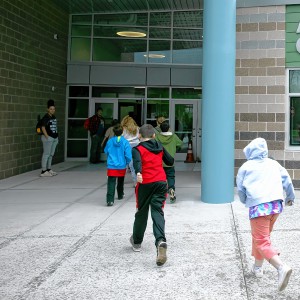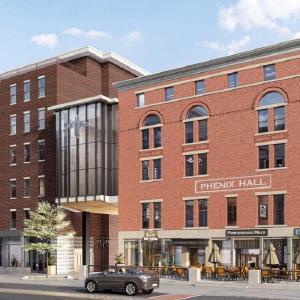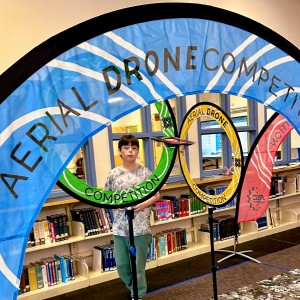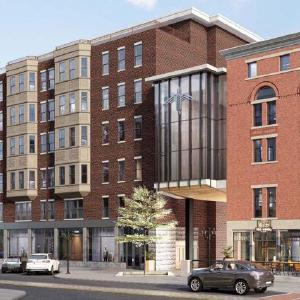Barnstead Elementary has relied on modular classrooms since 2001. It’s tenth in line for building aid.
| Published: 03-04-2023 7:29 PM |
Barnstead Elementary School fifth grade teacher Annabelle Boyle waved goodbye to her students as they put on their winter jackets in preparation to leave the classroom and head to their next class.
The jackets were necessary because when students exit Boyle’s classroom, they step directly outside into the crisp February air. That’s because Boyle’s room is one half of a modular classroom building – one of two such structures that sit adjacent to Barnstead Elementary’s main building. When students need to go from one class to another – or even when they need to use the bathroom – they must walk outside between the buildings.
School administrators placed the fifth grade in the modular classrooms because the students are old enough to walk between the buildings unsupervised but still small enough to fit in the rooms. Boyle, who maintains a cheery, positive attitude, has done her best to make her small, dark room as beautiful as possible, adding colorful curtains, wall art and decorative vines. But there’s no denying that teaching in the space is a challenge.
“It’s hard because there’s not a lot of room for them to move around,” Boyle said. “I don’t have room for a big table where I can sit down to teach small groups.”
To make matters more difficult, the other half of the modular building is the music classroom. Once the horns and the drums start up on the other side of the thinly constructed wall, it’s difficult for Boyle’s students to focus.
“My class is so chaotic, and it’s because I have so much going on next door,” Boyle said. “It is really impossible to control this age group when they have that noise.”
Barnstead’s two modular school buildings have been in use since 2001. School officials estimate the district has spent over $800,000 leasing them for the past two decades.
In 2022, Barnstead was one of 15 school districts that applied for state building aid to help fund a construction or renovation project. Their proposal was a $23 million project to provide an addition for classrooms, science labs and the unified arts program to support their expanding population.
Article continues after...
Yesterday's Most Read Articles
 Mother of two convicted of negligent homicide in fatal Loudon crash released on parole
Mother of two convicted of negligent homicide in fatal Loudon crash released on parole
 Students’ first glimpse of new Allenstown school draws awe
Students’ first glimpse of new Allenstown school draws awe
 Pay-by-bag works for most communities, but not Hopkinton
Pay-by-bag works for most communities, but not Hopkinton
 Regal Theater in Concord is closing Thursday
Regal Theater in Concord is closing Thursday
 With less than three months left, Concord Casino hasn’t found a buyer
With less than three months left, Concord Casino hasn’t found a buyer
 ‘Bridging the gap’: Phenix Hall pitch to soften downtown height rules moves forward
‘Bridging the gap’: Phenix Hall pitch to soften downtown height rules moves forward
They were ranked 10th on the priority list, putting them out of contention for any assistance. The situation creates a dire decision – ask taxpayers to foot the bill for a bond and pay for the project locally or wait another year and hope the district’s application scores higher next time.
For the school community, which has been struggling for decades with a facility too small to fit its needs, the disappointment is acute.
“My analysis of the existing system is that we will never get state building aid, I believe,” said Tim Broadrick, the superintendent of Barnstead, Alton and Prospect Mountain. “That’s kind of terrifying, because I don’t know if I’ll ever get this school renovated and expanded or a new school built in our economic climate.”
New Hampshire’s building aid program, which provides grants to help school districts fund a portion of their construction or renovation costs, began in 1955. In 2011, following the Great Recession, the state put a moratorium on funding new projects, which wasn’t lifted until 2020. Current state law contains a $50 million cap on money that can be allocated to the program. In 2022, the state received a record number of 17 applications, seeking a total of about $227.7 million in aid. State officials estimated that the program would have about $49 million in aid to give out, meaning only the top three districts on the list – Rochester, Colebrook and Monadnock – will get aid, unless the state allocates more money to the program. Concord’s proposed Rundlett Middle School building project was ranked fourth.
“If the legislature doesn’t change the way they fund it, we won’t get any money,” Broadrick said. “I’m more interested in trying to get people to look at the whole system and ask, ‘What is this going to mean for New Hampshire children over the next 20 or 40 years?’ ”
In his FY 2024 and 2025 budget, Gov. Chris Sununu is proposing $86.6 million in school building aid for the biennium and adding an additional $75 million to a new school building aid fund which would become available in July 2025 to fund school projects after the biennium.
“I am proposing a $75 million investment taken directly from the Education Trust Fund surplus to get assistance to ensure our buildings are as strong and reliable as the kids that count on them,” Sununu said at the time.
In the state legislature, five different bills have been filed relating to school building aid funding. Many of the bills seek to increase state funding to the building aid program, while others seek to make charter schools eligible for building aid, too.
Advocates of adding more funding to the program say it will help more New Hampshire schools make long-needed upgrades to their buildings, which they wouldn’t otherwise be able to afford.
“Having any floor amount would at least allow the program to know how much money is going to be coming in at a minimum,” said Amy C. Clark, a civil engineer and N.H. Department of Education administrator who oversees the building aid program. “I think that will probably really help schools plan or understand how much state funds they might be able to compete for, so that certainly would help schools.”
Barnstead Elementary’s space needs are significant. The school gymnasium, which most employees call the “cafegymatorium,” is where students have physical education classes and basketball practice and also where they eat lunch and have school assemblies. Each day after morning P.E. classes, the custodial staff fold out the tables in time for lunch. After lunch, the tables are put away and the floor is cleaned in time for more athletics. The space is too small for spectators at basketball games – so small that, according to Broadrick, other schools’ teams refuse to play there – so, instead, Barnstead’s basketball teams must play only away games.
The room where eighth grade science teacher Matthew Rayno teaches has a sink but has no other lab features. Rayno says he is unable to teach many of the chemistry lessons he would like, because the room is not equipped with the proper tools.
“You have to, at best, get very creative,” Rayno said. “But there’s also impossibilities. We don’t have ventilation; we don’t have eyewash stations. You can’t put everyone at hazard with mixing things, potential hazardous materials, if you don’t have something to take care of that.”
The kitchen, located just off the cafegymatorium, has one walk-in cooler, but its second walk-in cooler and freezer are located outside the building, meaning food service staff must exit the building to retrieve supplies. Storage is an issue everywhere. Topher Bishop, who runs the after-school program, stores his activity equipment in the hallway because there isn’t room in his office.
Michelle Rosado is a member of Barnstead’s school Space Needs Committee, a group made up of community members and town officials that has been meeting since 2021. Rosado, a lifelong resident who attended Barnstead Elementary herself, served on a past Space Needs Committee around 2016 and another one in the early 2000s, so she’s seen first-hand the long history of Barnstead’s building challenges. She clearly remembers when the decision was made in 2001 to bring in modular classrooms for the expanding student body.
“They thought, ‘Oh, we’ll bring these in, and it will just be temporary until we can bring forth some type of expansion to the school,’ and here we are in 2023, and those modulars still sit there,” Rosado said. “Everybody thought they were going to just be a temporary solution that was needed at the time.”
Barnstead, which experienced a 26.4% population increase from 2000 to 2020, is projecting an additional 5-20% increase in student enrollment in the next decade.
Barnstead is a rural residential community of about 4,000 residents located just south of the Lakes Region, though it lacks the tourism seen in other Lakes Region towns. Two gas stations, two general stores and a Dollar General make up the majority of the town’s commercial property tax base, meaning money raised for things like school building projects must come mostly from taxes paid by Barnstead families. In 2022, Barnstead’s total property tax valuation was $611 million, according to the NH Department of Revenue Administration. For context, Nashua has the largest valuation at $6 billion, and Ellsworth has the smallest at $19 million, excluding townships.
In 2016, the Space Needs Committee brought a warrant article to the annual district meeting, asking for $96,000 from an existing fund to be used for a schematic design for the future expansion project, which at the time was estimated it would cost $10-12 million. Residents rejected the article in a voice vote. At that time, the moratorium on state building aid was in effect, and the district was still paying off the debt service from building Prospect Mountain High School, which opened in 2004. Residents at the time didn’t want to start payments for an elementary school while still completing payments for the high school.
Even now, it’s a steep ask – even with building aid, school officials estimate the debt service for the $23 million elementary school project would double what it was for the high school. And without any building aid, members of the Space Needs Committee don’t even feel they can ask.
“We were like, ‘Can we just fund the project without building aid?’ ” Rosado recalled. “We kind of sat around and looked at each other, and we were just like, ‘Can we really ask that in good conscience of our neighbors and our families, our friends?’ And the resounding answer to that was ‘no.’ ”
The scoring of building aid applications takes into account a community’s economic need by looking at the number of children who receive free and reduced lunch. In Barnstead, 27% of students qualify for free and reduced lunch, according to Department of Education data. Broadrick believes the building aid scoring should also look at other economic factors, because free and reduced lunch numbers are based on how many fill out the forms.
‘Here, we’re begging people to fill out free and reduced lunch forms, and they don’t want to do it because they feel like, ‘I don’t need public assistance,’ not understanding that it’s hurting us,” Broadrick said.
Many school officials say the limited available funding means that applying for building aid can feel like a competition against other school districts, including larger districts that may have more political clout with the legislature.
“I don’t think that I should be competing against Concord,” Broadrick said. “I think both Rundlett and Barnstead Elementary need to be dealt with, and I think the real issue is that in this scarcity of resources, it has become super important to look at how the department is ranking these things.”
The scoring sheet that determines priority rankings assigns points to schools in 16 categories, such as overcrowding, security needs and unsafe structural conditions. The higher the school’s need in a particular category, the more points they receive, up to a total of 1,000. Rochester Elementary, ranked first on the list, received 828 points. Concord’s Rundlett Middle School received 722 points, and Barnstead received 435.
However, Clark emphasized that the scoring process doesn’t reward school districts for allowing their buildings to fall into disrepair. In the category of “maintenance,” schools are scored on the upkeep and care they put into their buildings.
“Schools can’t let their building go,” Clark explained. “Building aid does not pay for deferred maintenance or signs of neglect. You still have to pass your fire inspection, you still have to pass your health inspection, those things actually work against you in the ranking when you neglect your building or are ignoring deferred maintenance.”
Within the last two years, Barnstead Elementary found the money to replace its outdated fire alarm system after years of complaints from the local fire chief. They received a 0/70 in the category of “unsafe conditions – fire safety,” while the top three schools on the list received 70/70 points. Clark says fire safety points are not awarded for neglected maintenance but due to fire safety experts’ assessments that the building – for example, an old school built in the 1800s – is not up to code.
Barnstead received 125/125 for the category of “maintenance,” showing that they have been maintaining proper upkeep of their building. This round, every district on the list received identical maintenance points.
Clark said that while the return of the Building Aid Program is still new – currently nearing its third biennium post-moratorium – interest in re-evaluating the criteria has been brewing.
“There’s definitely been conversation about how it can improve and capture true measures,” Clark said. “Just like anything that goes through a process, there’s interest in learning what works and what doesn’t, and if it does really capture what people were interested in capturing.”
In the meantime, Barnstead’s project planning is in stasis, waiting to see what changes may come from the state.
“I have a lot of faith in our governor and our legislature,” Rosado said. “Schools shouldn’t be pitted against each other to compete for money. I’m hoping that the governor and the legislature see it that way and that they will fund building aid this year for all of these projects. I know that’s a big ask, but it’s important ask.”


 Kearsarge Middle School drone team headed to West Virginia competition
Kearsarge Middle School drone team headed to West Virginia competition Phenix Hall, Christ the King food pantry, rail trail on Concord planning board’s agenda
Phenix Hall, Christ the King food pantry, rail trail on Concord planning board’s agenda Granite Geek: Forest streams are so pretty; too bad they’re such a pain to measure
Granite Geek: Forest streams are so pretty; too bad they’re such a pain to measure
